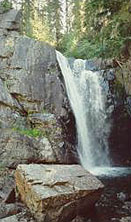Running
Water

Running water is the most
powerful agent of erosion. Continents are eroded primarily by running water
at an average rate of 1 inch every 750 years. The velocity of a stream increases
as its gradient increases but velocity is also influenced by factors such as
degree of turbulence, position within the river, the course of the stream, the
shape of the channel and the stream load.
River
Cycles
Stages in the
cycle of river erosion are labeled as youth, maturity and old age. Each stage
has certain characteristics that are not necessarily related to age in years
- only phases in development. Typically, rivers tend to have old-age-type development
at their initial mouths and youthful development at their upper reaches. So
the three stages may grade imperceptibly from one to another and also from one
end of the stream to the other.
The youthful
stage is characterized by rapid downcutting, high stream gradient, steep-sided
valleys with narrow bottoms and waterfalls. The mature
stage is characterized by a longer, smoother profile and no waterfalls or
rapids.
Gradient is normally expressed
as the number of feet a stream descends each mile of flow. In general, a stream's
gradient decreases from its headwaters toward
its mouth, resulting in a longitudinal profile concave towards the sky.
Base
Level
The base level
of a stream is defined as the lowest level to which a stream can erode its channel.
An obstacle such as a resistant rock across a stream can create a temporary
base level. For example, if a stream passes into a lake, it cannot erode below
the level of the lake until the lake is destroyed. Therefore different stretches
of a river may be influenced by several temporary base levels. Of course the
erosive power of a stream is always influenced by the ocean which is the ultimate
base level below which no stream can erode. Many streams in Idaho eventually
reach the ocean through the Columbia River.
If the base level is raised
in some manner such as by a landslide blocking a stream, the stream's velocity
is reduced and it can no longer carry as much material. Sedimentary material
will then be deposited in the lake formed by the landslide. Conversely, if the
base level is lowered, the stream will begin eroding its channel downward.
Transportation
of Material
Running water
transports material in 3 ways: solution, suspension and by rolling and bouncing
on the stream bottom.  Dissolved
material is carried in suspension. About 270 million tons of dissolved material
is delivered yearly to the oceans from streams in the United States. Particles
of clay, silt and sand are generally carried along in the turbulent current
of a stream. Some particles are too large and heavy to be picked up by water
currents, but may be pushed and shoved along the stream bed.
Dissolved
material is carried in suspension. About 270 million tons of dissolved material
is delivered yearly to the oceans from streams in the United States. Particles
of clay, silt and sand are generally carried along in the turbulent current
of a stream. Some particles are too large and heavy to be picked up by water
currents, but may be pushed and shoved along the stream bed.
Waterfalls
Waterfalls are
a fascinating and relatively rare occurrence. Waterfalls may be caused in several
ways. For example, where a relatively resistant bed of rock overlies less resistant
rock, undermining of the less resistant rocks can cause a falls. Waterfalls
are short-lived features in the history of a stream as they are created by a
temporary base level. As time passes, falls may slowly retreat upstream, perhaps
as rapidly as several feet per year. There are many spectacular waterfalls in
Idaho, including the 212-foot-high Shoshone
Falls in the Snake River Canyon just north of Twin Falls.
Source
Information
 Dissolved
material is carried in suspension. About 270 million tons of dissolved material
is delivered yearly to the oceans from streams in the United States. Particles
of clay, silt and sand are generally carried along in the turbulent current
of a stream. Some particles are too large and heavy to be picked up by water
currents, but may be pushed and shoved along the stream bed.
Dissolved
material is carried in suspension. About 270 million tons of dissolved material
is delivered yearly to the oceans from streams in the United States. Particles
of clay, silt and sand are generally carried along in the turbulent current
of a stream. Some particles are too large and heavy to be picked up by water
currents, but may be pushed and shoved along the stream bed.